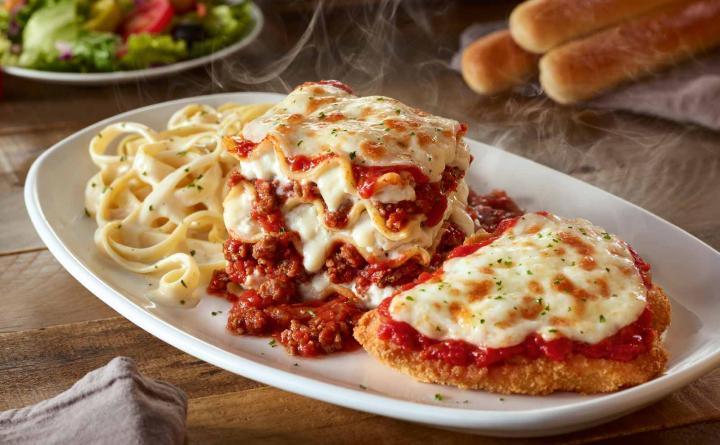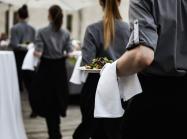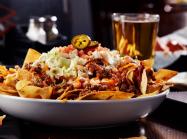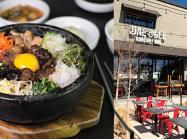Our new report this year ranks the largest brands in the sector, offering a glimpse what the future holds.
Our new report this year highlights the powerhouse brands making legendary status in restaurant chain history. Though varied by cuisine type, these full-service restaurants all showcase recent growth rooted in culinary and technological innovation, and have not only stood the test of time, but also survived the pandemic and come out stronger on the other side.
The below powerhouses have mastered the art of crafting unforgettable dining experiences at affordable, everyday prices, capturing customers’ attention and loyalty. In this comprehensive report, we delve into the captivating world of these full-serve, casual dining titans.
- Olive Garden
Heading into fiscal 2023, guest satisfaction metrics at Olive Garden were at an all-time high, thanks in large part to improved staffing levels, along with ongoing efforts to streamline operations and reduce complexity in the kitchen. Parent company Darden Restaurants has underpriced inflation by more than 400 basis points and underpriced the full-service segment by more than 600 basis points in the past three years, and consumers have responded by staying put. At the same time, the company has committed to stopping deep discounting. The closest it came to a promotional deal was the return of Olive Garden’s Never-Ending Pasta Bowl in Q2. The item, which is likely to be the chain’s only LTO this year, was priced $3 higher than its previous rollout, but still delivered a sizable lift to traffic and sales during its seven-week run.
- Texas Roadhouse
To gain perspective on the run Texas Roadhouse has put down, it helps to look back. In 2017, this was a $2 billion company with 549 locations across its footprint. Five years later, pandemic and all, the chain doubled to about $4 billion in revenue as it spread to 697 venues (including 652 Texas Roadhouses, 40 Bubba’s 33 units, and five Jaggers, the company’s fast casual offshoot). But beyond material growth, Texas Roadhouse’s story is one of resiliency and reemergence, and in both cases, the brand leaving the pandemic behind is more dynamic than ever. It opened 2023 generating weekly sales north of $146,000. Texas Roadhouse averaged more guests in the calendar’s first seven weeks than any period in its history. On the doorstep of COVID, the brand generated roughly $113,777. One of the big kickers has been to-go sales—off-premises accounted for $8,741 pre-virus. Today, it’s closer to $19,000. And the momentum isn’t tailing off. Texas Roadhouse grew its same-store sales 12.9 percent at company units in Q1 2023 and hit a record weekly figure of $148,437, besting a high mark set the previous quarter.
- Chili’s
Chili’s CEO Kevin Hochman began his tenure in June 2022, and his impact was immediate. The industry veteran entered the brand with big initiatives, like the reduction of deep discounting, cutting costs in the back of house, and rethinking the company’s approach to virtual brands and technological initiatives. When Hochman joined last year, Chili's discounted items mixed 37 percent. By November, that decreased to 30 percent. Now the chain is around 29 percent. Also, Chili’s discontinued virtual concept Maggiano’s Italian Classics to focus more on dine-in and suspended testing of “Rita the Robot,” a machine that could host, wait on guests, and clear tables. Cost savings cleared the way for Chili’s to implement TV advertising for the first time in three years. The brand drove traffic and frequency by highlighting its 3 for Me value platform during prime-time TV and March Madness basketball games and on major streaming sites like Hulu and Paramount+.
- Applebee’s
Tony Moralejo, after three years as president of Dine Brands’ international segment, assumed the president role in January when John Cywinski headed to QDOBA. He stepped into a rocky operating environment. On the positive side, the chain closed 2022 with same-store sales growth of 1.7 percent—its eight straight period of positive gains. It also lapped a previous year result of 9.1 percent over 2019. However, Applebee’s, which closed about 300 underperforming U.S. units across a five-year stretch, had to scale back previous plans to hit net unit growth in 2023. Yet it still believes it’ll open more stores than last year, only with a net loss of 10–20 outlets. But even with macroeconomic pressures stalling development, the brand continues to serve a resilient guest. The eight-quarter streak stretched into nine to begin 2023, with comps rising 5.1 percent. And Applebee’s told investors it held its No. 1 ranking across key consumer metrics like convenience and variety, per the company’s proprietary third-party tracker. Brand awareness was at an all-time high thanks to affordability and menu breadth. Sales rode promotions and abundant value programs, like the Two for $25 and $14.99 all-you-can-eat boneless wings, riblets, and shrimp. It gave management reason to not only be optimistic going forward, but to feel insulated against whatever challenge comes next.
- Buffalo Wild Wings
Within the past year, Buffalo Wild Wings has been no stranger to menu innovation. In June 2022, the sit-down sports bar chain launched Happy Hour and its new Bird Dawgs—hand-breaded chicken tenders on a brioche bun, loaded with sauces and toppings. The chain followed that up a month later with its Saucy Chicken Sandwich, taking a page out of the quick-service playbook. The major difference being the chicken can be covered in any of Buffalo Wild Wings’ 26 signature sauces. Then, in August 2022, the casual-dining chain entered the pizza category with its Boneless Bar Pizza, an item featuring a thin-crust base topped with boneless wings. In terms of sauces, Buffalo Wild Wings partnered with New York Jets cornerback Ahmad Gardner to release a limited-time “Sauce Sauce,” and it rolled out new General Tso’s and Sweet Chili Lime sauces ahead of the summer.
- IHOP
Though IHOP recently decided to pull the plug on its fast-casual spinoff pilot program ‘Flip’d,’ the casual-dining breakfast chain opened 19 locations systemwide in the first quarter of 2023, ending Q1 with 1,790 stores. Driven by internal brand research, IHOP launched its largest menu evolution to-date in March, with a lineup stretching across dayparts and categories and a goal of highlighting quality ingredients, and options that meet the indulgent and lighter side of cravings, choice, and value. The revamp featured a fresh take on Sweet & Savory Crepes, Eggs Benedicts, Ultimate Steakburgers, a new Four-Cheese Crisp, fish and shrimp, and the return of Cinn-A-Stack Pancakes. Additionally, the brand enrolled 5.5 million members in the first year of its loyalty program launch, which drives frequency, share of wallet, and average check, and allows IHOP to better engage with guests through targeted promotions and differentiated in-restaurant experiences.
- Cracker Barrel
Despite the threat of recession and decreased foot traffic, Cracker Barrel finished the 2022 fiscal year strong with an estimated $2.6 billion in sales and an AUV of $3.92 million. The family-style restaurant leaned into both menu strength and value proposition with programs like Build Your Own Homestyle Breakfast, 20 meals under $12, $5 take-home meals, and a growing beer and wine menu. The company also rolled out a new app later in the year that will serve as the foundation for a loyalty program and boost interest with a younger customer base. Efforts to improve technology didn’t stop there; the chain also introduced Apply Pay and Google Pay later in Q4. Overall, Cracker Barrel’s performance amidst a questionable economic background can be credited to its dedication to deploying strategies for every guest, young and old.
- Outback Steakhouse
Outback’s growth trajectory is becoming larger by focusing on a smaller prototype. The store design is 5,000 square feet—a reduction of 16 percent—thanks to restructuring in the kitchen and dining room. However, it was done without impacting the guest experience or cutting the number of tables. In addition to a new size, the prototype brings a bright ambiance, a reimagined bar, and an elevated décor package that modernizes “the look and feel while also highlighting Outback’s Aussie heritage,” according to CFO Chris Meyer. The new asset costs 20 percent less than a traditionally sized outlet. New technology, like advanced grills and ovens, kitchen display systems, and handheld tablets for servers will be incorporated into the new building, as well as a space carved out for off-premises business. Outback believes there’s room for 75-100 more units in the U.S. in markets such as Austin, Texas; Miami; and Nashville, Tennessee.
- LongHorn Steakhouse
Like its sister concept Olive Garden, LongHorn continues to reap benefits from Darden’s decision to underprice inflation (400 basis points over the past three years, industry-wide). LongHorn set weekly sales records multiple times in its most recent quarter. The brand’s average weekly sales of $96,905 pulled out to annualized volumes of $5.01 million. That’s a major jump from 2020, when it was $76,101. LongHorn’s total sales of $1.9 billion represented a company record as well. Comps rose 10.8 percent and the chain enjoyed 17.4 percent margin, 80 basis points higher, year-over-year. When Darden acquired LongHorn, it closed the following year (2008) with 305 locations. That would balloon to 514 by 2019 and now sits at 554.
- Denny’s
The casual breakfast dining chain recently invested more than $25 million to improve and upgrade kitchen equipment, propelling the development of menu innovation while increasing efficiency and reducing waste. After completing the initiative, the brand launched a new menu featuring a custom augmented reality (AR) experience. Recent additions like Mac N' Brisket Sizzlin' Skillet, Oven-Baked Lasagna, and Caramel Apple Pie Crisp are resonating with guests and outperforming expectations, leading to an 8.4 percent increase in systemwide same-store sales in the first quarter of 2023—the strongest new dinner product launch since prior to the pandemic. Plus, a new conversion to a common network service provider will improve kitchen verification systems, server tablets, and QR pay. Denny’s is also making progress on its “big three” near-term initiatives, which include staffing, 24/7 operations, and value.
- The Cheesecake Factory
With a new Cheesecake Rewards loyalty program set to launch nationwide this summer, the casual dining concept considers itself a leader in the experiential dining category, differentiated by its 235 menu items made fresh from scratch, plus an integrated bakery that produces more than 60 cheesecakes and other baked goods. Same-store sales at the Calabasas Hills, California-based company rose 5.7 percent in the first quarter of 2023 year-over-year, and revenues reached $866.1 million.
- Golden Corral
COVID hit Golden Corral hard, with the buffet chain losing a net of 124 restaurants across 2020 and 2021, but the bounce back is already underway. Last year, the brand grew by a net of three stores. Also, Golden Corral has solidified plans to open Homeward Kitchen, a new fast-casual spinoff set to debut in Southern Pines, North Carolina, later this year. It will have a drive-thru, along with a mixture of classic and modern menu items.
- Red Lobster
Sales at Red Lobster still haven’t returned to their pre-pandemic benchmark. The 644-unit chain also has shrunk its footprint over the past several years, and it’s faced a series of turnover in its executive ranks. Still, parent company Thai Union is confident in the seafood chain’s strategy for a turnaround, which includes a focus on menu enhancements, value deals, and operational improvements.
- Red Robin
The casual burger brand is another full-serve forging ahead with fresh leadership. Industry vet GJ Hart, the former Texas Roadhouse, CPK, and Torchy’s Taco CEO, assumed the reins last July. He got to work quickly. Red Robin revealed a five-point “North Star” plan in January that covered everything from staffing to food quality to removing costs and complexity. While a journey in motion, results flashed brightly in Q1 2023 as Red Robin posted more than 700 new sales records. More updates are on deck this year, including flat-top grills and ample menu innovation.
- Waffle House
At over 1,900 locations across the United States, it can’t be denied that Waffle House has become a beacon of breakfast since 1955. The family-style restaurant continues to serve guests 24/7, 365, so much so that the Federal Emergency Management Agency uses the “Waffle House Index” to measure the seriousness of an incoming hurricane or tropical storm. Even when faced with rising food costs, namely eggs, Waffle House holds onto its cheap prices to keep its cult-like following alive.
- B.J’s Restaurant
Sales at BJ’s Restaurants grew 18.1 percent to $1.3 billion in fiscal 2022, with comps up 14 percent. The momentum is giving CEO Greg Levin confidence in the company’s long-term ability to double its footprint and become a $2 billion business, even as it slows down the pace of new builds in the near-term. Soaring costs for construction have pushed BJ’s to prioritize its remodel program, which centers around an updated bar statement and expanded seating capacity.
- First Watch
The breakfast leader is simply one of the nation’s hottest chains. It jumped out of 2023 with same-store sales growth of 12.9 percent, year-over-year, lapping 21.9 percent growth in 2022. Perhaps most impressive, though, First Watch reported same-restaurant traffic growth of 5.1 percent, which was 11.7 percent better than Q1 2019. Same-store sales are 42 percent higher on a three-year view. After opening 10 restaurants in Q1, First Watch finished the quarter with 484 stores, including 370 company-owned and 114 franchises across 29 states.
- TGI Fridays
CEO Ray Blanchette departed TGI Fridays in May after leading the 301-unit brand since October 2018. Rohit Manocha, chairman of the board and cofounder of TGI Fridays’ lead investor TriArtisan Capital Advisors, took over as the chain searched for a replacement. The brand said it was entering “a new phase of revitalization.” TGI Fridays’ same-store sales last year grew 8 percent against 2019. It also recently introduced a fresh rewards platform that offers daily options and makes it simpler for guests to engage.
- P.F. Chang’s
P.F Chang’s off-premises concept is thriving, but that doesn’t mean it’s veering away from the dining room experience. The P.F. Chang’s To Go concept has expanded to roughly 20 locations since launching in 2020, but executives at the 219-unit chain see plenty of runway for both the off-premises-only and full-service bistro models. The company is embarking on a brand refresh across the U.S., and all of its domestic restaurants are receiving renovations, including new decor and menu presentations.
- Hooters
Hooters is celebrating its 40th anniversary this year by encouraging more growth beyond its current 288-unit footprint. The brand revealed in March that it was giving away 40 weeks of free royalties for any new franchisee that signs on for a franchise in 2023. The initiative is part of the brand’s long-term goal “to make bold and innovative moves in the full-service restaurant category, strengthen its core, and enhance the entertainment draw of its in-person dining experience.
- Dave & Busters
Dave & Buster’s is looking to own the eatertainment category—for both young adults and families—with its $835 million acquisition of Main Event. Strategies are now underway to create an environment where guest flow becomes more efficient and complexities in operations are removed from the back of house. Both companies are working to develop the right staffing model, reporting tools, and management approach to maximize throughput.
- Carrabba’s Italian Grill
Carrabba’s opened a restaurant in Tampa in Q3 of 2022, marking its first new location since 2015. Bloomin’ Brands CEO David Deno said the 218-unit Italian chain earned the right to expand after landing among the company’s top performers for the past several years. In addition to traditional stores, Carraba’s is exploring a takeout/delivery-focused model because of its robust off-premises business, which now accounts for more than a third of its total sales.
- Bob Evans
Despite inflationary pressures, Bob Evans Restaurants has managed to fulfill its brand promise of “keeping the entire family full and happy for less.” Under its “American Values” menu, Bob Evans offers multiple meals for less than $9, with pick-two lunch combos starting at $6.99. The New Albany, Ohio-based American casual dining chain has 443 locations in 18 states, primarily in the Midwest, mid-Atlantic, and Southeast regions of the U.S.
- California Pizza Kitchen
Jeff Warne took the helm at California Pizza Kitchen (CPK) in December 2022. He succeeded Jim Hyatt, who ran the company for nearly five years. The leadership shakeup followed an up-and-down pandemic journey. CPK filed for bankruptcy in mid-2020, citing COVID and increased competition from fast casuals. By the time Warne was promoted to CEO, the 146-unit pizza chain had returned to pre-pandemic sales levels, thanks to investments in CPK Rewards, menu innovation, and improvements to the digital guest experience.
- Perkins Restaurant & Bakery
The 65-year-old classic diner chain shook up its traditional operating model recently with a refreshed prototype, virtual partnerships, and new labor-saving technology, which lowers development costs for franchise owners. In March, the restaurant and bakery chain announced the signing of a new franchise agreement to grow its presence across Ohio, and has 276 locations in 32 states, plus two Canadian provinces.
- The Capital Grille
At 61 locations, The Capital Grille represents the fine-dining side of Darden Concept’s portfolio. The steakhouse seeks to draw in customers through its extensive wine menu and private dining experiences. Its virtual service, a mobile app called Concierge, allows guests to save their favorite wines and make reservations. Overall, Capital Grille performed well during the fiscal year of 2022, sharing an 11.7 percent same-store sales growth in Q3 with Cheddar’s Scratch Kitchen.
- Bonefish Grill
The “Big City Bar and Restaurant” has weathered lower traffic and tightening wallets but shows no sign of wear. The casual-dining seafood concept, helmed by Bloomin’ Brands, saw a 5.2 percent rise in same-store sales in Q1, with 180 locations and counting. With the addition of a Sunday brunch to the menu, a rotating array of seasonal favorites, and an emphasis on catering, Bonefish Grill is doubling down on growth trajectories.
- Cheddar’s Scratch Kitchen
Since Darden acquired Cheddar’s in 2017, it has grown to be the third-largest brand in the group’s portfolio, behind Olive Garden and LongHorn Steakhouse. The scratch kitchen saw growth in store footprint of four percent, with 183 stores and counting. Overall, same-store sales increased by 11.7 percent in Q3, accounting for a record $1.56 billion. Cheddar’s is growing at a calculated pace, and Darden’s CEO Rick Cardenas believes the brand’s strong leadership team will catapult it to success.
- Fogo de Chão
The Brazilian all-you-can-eat steakhouse chain is expanding its footprint across the world to Ecuador, Turkey, Rhode Island, and more. In May, Fogo de Chão signed a lease to open its third Bay Area location in California, supporting the brand’s continued 15 percent annual restaurant growth across the U.S. In 2023, Fogo de Chão signed 12 new domestic and international leases and opened in key markets in Washington, Maryland, California, and New Jersey.
- Ruby Tuesday
Following tumultuous challenges during the pandemic, Ruby Tuesday filed for bankruptcy in late 2020. The classic bar & grill chain shuttered 185 company-owned restaurants, a far cry from 724 units in May 2016. Despite this, Ruby Tuesday has rebounded by reducing liabilities and restructuring its organization. With the help of a “Daily Deals” program and a reenergized focus on off-premises business, the classic bar & grill chain continues to make a promising comeback.
Methodology:
The FSR Top 30 Report leverages multiple data products and services from Circana’s unmatched research product portfolio, combined with experienced analyst estimates. Sales estimates represent each chain’s total U.S. system for the year ending December 2022, and are anchored on CREST®, Circana’s flagship syndicated study of consumer purchases of restaurant-prepared meals, snacks, and beverages. Unit counts source to the Fall 2022 release of Circana’s ReCount® service, a census of chains and independent restaurant locations regularly updated since 1988. Today, ReCount provides unit counts and trends for over 1.2 million foodservice operators. These primary sources, combined with other proprietary Circana data, public reporting, and analysis, generate this new, industry-standard restaurant ranking.
Circana is the leading advisor on the complexity of consumer behavior. Through unparalleled technology, advanced analytics, cross-industry data and deep expertise, we provide clarity that helps almost 7,000 of the world’s leading brands and retailers take action and unlock business growth. We understand more about the complete consumer, the complete store, and the complete wallet so our clients can go beyond the data to apply insights, ignite innovation, meet consumer demand, and outpace the competition.

















